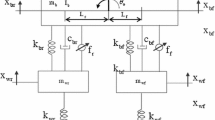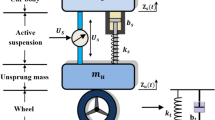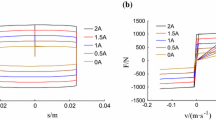Abstract
A suspension-type small vehicle has the significant advantages of high efficiency, convenience and environmental protection due to its flexible scheduling and compact vehicle structure, but its narrow available space also limits ride comfort. Due to the influences of various factors, such as a large lateral force applied on the steering arm, a large centrifugal force and a large crosswind force, the guide wheel and track side may be subjected to a large impact, so that passengers’ ride comfort becomes worse. In this study, first, The swing mechanism of side force on suspension vehicle is analyzed, the theoretical model of vertical load reallocation between left and right wheels of vehicles under the lateral force on the steering arm, centrifugal force and crosswind load is established to analyze the influences of vertical load reallocation of left and right wheels on tire cornering stiffness and steady-state response. Then, based on the improved distributed double-bogie 8-hub motor driving mode, with the minimum displacement amount of the displacement sensor and the minimum roll angle of the vehicle as the optimization targets. The PID closed-loop control strategy is constructed by processing the data of guide wheel displacement sensor and vehicle gyroscope with Kalman filter to realize the closed-loop adaptive control of vehicle driving attitude. Then, the anti-interference ability of the classical PID control strategy is improved by introducing the fuzzy control into the PID control and the robustness of the system is improved by modifying the controller parameters in real time. Finally, the driving states of the vehicle are experimentally compared under three control modes: non-PID control, PID closed-loop control and fuzzy PID control. In addition, the ride comfort is evaluated to verify the control algorithm. The experimental results showed that the roll angle and lateral acceleration of the suspension-type small rail vehicle based on the fuzzy PID control system were significantly improved and the anti-interference ability and the stability of the vehicle were also largely enhanced. The study provides the basis for improving ride comfort of suspension-type small rail vehicles.


























Similar content being viewed by others
Data availability
The data used to support the findings of this study are available from the corresponding author upon request.
References
Tahmasseby S, Kattan L (2015) Preliminary economic appraisal of personal rapid transit (PRT) and urban gondola feeder systems serving a university campus and its surrounding major attractions. Can J Civ Eng 42(1):67–79
Lv K, Wang K, Chen Z, Cai C, Guo L (2017) Influence of wheel eccentricity on vertical vibration of suspended monorail vehicle: experiment and simulation. Shock Vib 2017:1–10
Liu B, Yue H, Lin J, Lin J, Wu X, Shi Z (2020) Analysis and optimization of driving attitude and oscillation characteristics of suspension-type small rail vehicles. Shock Vib 18:1–21
Claudia B, Michael P, Vishakha M, Michael H (2009) Assessing public preferences for design and environmental attributes of an urban automated transportation system. Landsc Urban Plan 90(3–4):155–167
Anderson JE (2000) A review of the state of the art of personal rapid transit. J Adv Transp 34(1):3–29
Landers J (2010) Personal rapid transit system begins test runs at heathrow airport. Civ Eng 80(12):24–25
Kerr T, Lowson M, Smith A (2014) Heathrow airport’s personal rapid transit system proves to be a viable transport solution. Proc Inst Civil Eng 167(2):66–73
Cai C, He Q, Zhu S, Zhai W, Wang M (2019) Dynamic interaction of suspension-type monorail vehicle and bridge: numerical simulation and experiment. Mech Syst Signal Process 118:388–407
He Q, Cai C, Zhu S, Wang M, Wang K, Zhai W (2020) Key parameter selection of suspended monorail system based on vehicle–bridge dynamical interaction analysis. Veh Syst Dyn 58(3):339–356
Jiang Y, Wu P, Zeng J, Wu X, Zhang Y (2021) Researches on the resonance of a new type of suspended monorail vehicle-bridge coupling system based on modal analysis and rigid-flexible coupling dynamics. Veh Syst Dyn 59(1):135–154
Bao Y, Li Y, Ding J (2016) A case study of dynamic response analysis and safety assessment for a suspended monorail system. Int J Environ Res Public Health 13(11):1121–1138
Guo Q, Wang P, Chen J, Xu J, Xu H (2018) Dynamic analysis on suspended monorail vehicles passing through turnouts. In: IOP conference series: materials science and engineering, Singapore, 14–16 September 2018, pp 1–9
He Q, Cai C, Zhu S, Wang K, Zhai W (2020) Improvement on curve negotiation performance of suspended monorail vehicle considering flexible guideway. Int J Struct Stab Dyn 20(05):2050057
Guo Q, Wang P, Xu J, Yu H, Li C (2018) Research on reasonable line type of suspended monorail turnout. In: IOP conference series: materials science and engineering, Singapore, 14–16 September 2018, p 042077. https://doi.org/10.1088/1757-899X/439/4/042077
Jiang Y, Wu P, Zeng J, Zhang Y, Zhang Y, Wang S (2019) Multi-parameter and multi-objective optimisation of articulated monorail vehicle system dynamics using genetic algorithm. Veh Syst Dyn 58(47):1–18
Zhou J, Du Z, Yang Z, Xu Z (2020) Dynamic parameters optimization of straddle-type monorail vehicles based multiobjective collaborative optimization algorithm. Veh Syst Dyn 53(3):357–376
Lin J, Lai H, Chang J (2018) Stabilization and equilibrium control for electrically cart–seesaw systems by neuro-fuzzy approach. J Vibr Eng Technol 6(1):1–11
Jamadar ME, Desai RM, Saini RS, Kumar H, Joladarashi S (2021) Dynamic analysis of a quarter car model with semi-active seat suspension using a novel model for magneto-rheological (MR) damper. J Vib Eng Technol 9(1):161–176
Munawwarah S, Yakub F (2021) Control analysis of vehicle ride comfort through integrated control devices on the quarter and half car active suspension systems. Proc Inst Mech Eng D J Automob Eng 235(5):1256–1268
Wu Y, Wang C, Zhou L, Ou L (2009) A simulation of vehicle lateral stability based on fuzzy PID control. In: 2009 international conference on measuring technology and mechatronics automation, Wu Hunan, China, 11–12 April 2009, pp 194–199
Li H, Wen Q (2018) A study on active suspension co-simulation of off-road vehicle based on the fuzzy-PID control strategy. Mod Manuf Eng 451(4):99–102
Ye Z, Wang L, Yang X, Yuan L, Zhang Z (2015) Study on the ride performance of a semi-active air suspension vehicle under complex models based on co-simulation. SAE Tech Papers. https://doi.org/10.4271/2015-01-0614
Zeinali M, Darus IZM (2012) Fuzzy PID controller simulation for a quarter-car semi-active suspension system using Magnetorheological damper. In: 2012 IEEE conference on control, systems & industrial informatics, Bandung, Indonesia, 23–26 September 2012, pp 104–108
Zhu W, Chen Y (2004) Application and simulation of automotive ABS using fuzzy PID control. J Jiangsu Univ (Natl Sci Edn) 25(4):310–314
Pérez-Pimentel Y, Osuna-Galán I, Avilés-Cruz C, Villegas-Cortez J (2018) Power supply management for an electric vehicle using fuzzy logic. Appl Comput Intell Soft Comput. https://doi.org/10.1155/2018/2846748
Ji X, Li S (2009) Design of the fuzzy-PID controller for new vehicle active suspension with electro-hydrostatic actuator. In: 2009 4th IEEE conference on industrial electronics and applications, 25–27 May Xi'an, China, pp 3724–3727
Yu Z (2018) Automotive theory, 5th edn. China Machine Press, Beijing
Sakunthala S, Kiranmayi R, Mandadi PN (2017) A study on industrial motor drives: comparison and applications of PMSM and BLDC motor drives. In: 2017 international conference on energy, communication, data analytics and soft computing, Chennai, Tamil Nadu, India, 1–2 August 2017, pp 537–540
Park SZ, Kim YK, Song CH, Lee JW, Mok HS (2011) Operation method of electric bicycle using change of BLDC operation mode and PMSM operation mode. In: 8th international conference on power electronics-ECCE Asia, Jeju, Korea (South), 30 May–3 June 2011, pp 2529–2536
Korkmaz F, Topaloğlu İ, Çakir MF, Gürbüz R (2013) Comparative performance evaluation of FOC and DTC controlled PMSM drives. In: 4th international conference on power engineering, energy and electrical drives, Istanbul, Turkey, 13–17 May 2013, pp 705–708
Welch G, Bishop G (1995) An introduction to the Kalman filter, pp 127–132
Liu W, Dai J (2015) Design of attitude sensor acquisition system based on STM32. In: 2015 fifth international conference on instrumentation and measurement, computer, communication and control (IMCCC), Qinhuangdao, China, 18–20 September 2015, pp 1850–1853
Romaniuk S, Gosiewski Z (2014) Kalman filter realization for orientation and position estimation on dedicated processor. Acta Mech Autom 8(2):88–94
Astrom K, Hagglind T (1995) PID controller: theory, design and tuning. Instrument Society of American, Raleigh
Bialkowski W (1996) Control of pulp and paper making process. In: Lenine W (ed) The control handbook. IEEE Press, New York
Silva G, Datta A, Bhattacharyya S (2002) New results on the synthesis of PID controllers. IEEE Trans Autom Control 47(2):241–252
Funding
The research was supported by Jiangsu Tianle Intelligent Technology Co., Ltd. and the National Natural Science Foundation of China (Grant No. 51905010).
Author information
Authors and Affiliations
Corresponding author
Ethics declarations
Conflict of Interest
The authors declare that there are no competing interests regarding the publication of this article.
Additional information
Publisher's Note
Springer Nature remains neutral with regard to jurisdictional claims in published maps and institutional affiliations.
Rights and permissions
About this article
Cite this article
Zhang, P., Yue, H., Shi, Z. et al. A Fuzzy PID Algorithm-Based Attitude Control Method of Suspension-Type Small Rail Vehicles. J. Vib. Eng. Technol. 10, 111–130 (2022). https://doi.org/10.1007/s42417-021-00367-x
Received:
Revised:
Accepted:
Published:
Issue Date:
DOI: https://doi.org/10.1007/s42417-021-00367-x




